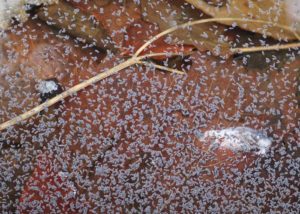Howdy, BugFans,
The BugLady was working on this week’s episode about a lovely little spider, but then she took a walk at the north end of the Bog and encountered a mob of springtails. She searched for a collective noun for springtails and found a few on-line discussions about it. “Mass aggregation” is the science-y choice, but other suggestions were cluster, swarm, sprinkle (for a small swarm), furcula (in honor of the springtail’s jumping appendage – teachable moment), and sproing.
She was walking along a short, wetland boardwalk and noticed that the surface of a small pool of water looked gritty. Pollen from above? The maples aren’t in bloom yet, the ash trees are dead, and spring ephemerals are weeks away. Not pollen. But, on sticks and wet leaves at the edges of the pool and on the end of the boards there were masses of springtails, and she realized that the specks on the open water were springtails, too. (The other folks on the trail gave her an extra-wide “social distance” berth when she said “Excellent” in a loud voice and started snapping pictures, apparently of the ground).
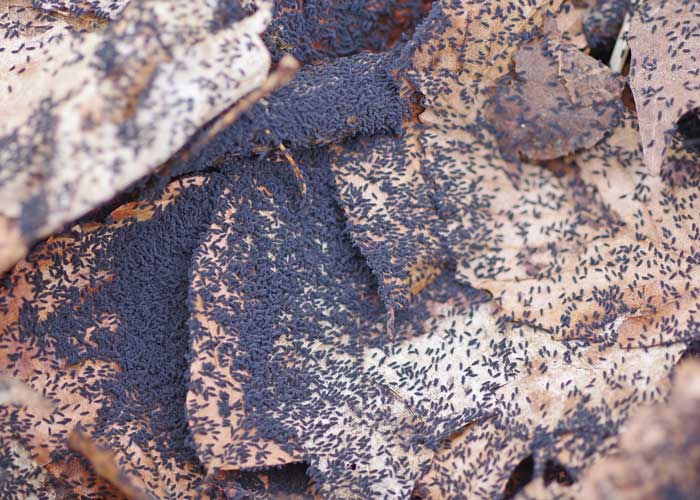 Springtails have appeared in these pages before, most recently in the form of “Semi-aquatic Springtails” in 2014 and “Super Springtails” in 2016. You can find out about their basic biology (and vocabulary) in either. The short version: Although they have six legs, springtails are no longer classified as insects, but are now in their own Class, Collembola, making them peers of Insecta, also a Class.
Springtails have appeared in these pages before, most recently in the form of “Semi-aquatic Springtails” in 2014 and “Super Springtails” in 2016. You can find out about their basic biology (and vocabulary) in either. The short version: Although they have six legs, springtails are no longer classified as insects, but are now in their own Class, Collembola, making them peers of Insecta, also a Class.
They are wingless, but most have a furcula that allows them to leap into the air. Every once in a while, as the BugLady watched, an individual would levitate above the crowd. They are decomposers, feeding mostly on rotting vegetable matter; they have taste organs at the tips of their antennae; they usually live in moist habitats in or under leaf litter, bark, and fungi; and some species are found on/around water. They’ve been here for 400 million years, give or take.
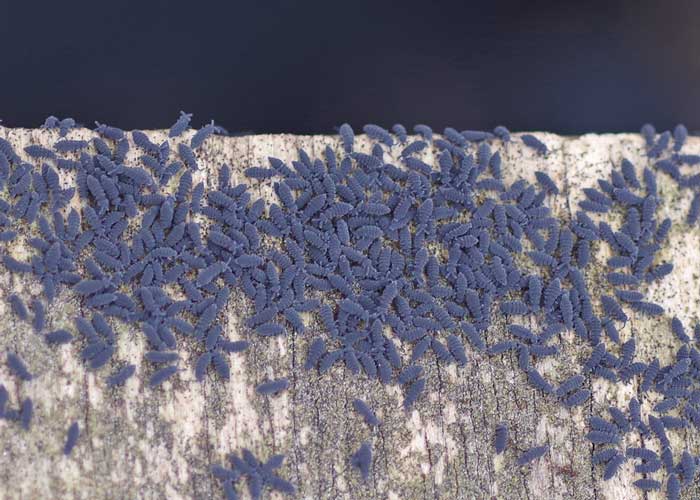 The first question is always “what is it?” because that answer opens the doors to finding out what it does for a living and where it fits in. There is an aquatic springtail called Podura aquatica that has reddish antennae and legs and a pincer-like furcula. The BugLady really squinted at her pictures, noticing that a few of the legs looked marginally purple, but mostly not. All the furculae she could see were straight.
The first question is always “what is it?” because that answer opens the doors to finding out what it does for a living and where it fits in. There is an aquatic springtail called Podura aquatica that has reddish antennae and legs and a pincer-like furcula. The BugLady really squinted at her pictures, noticing that a few of the legs looked marginally purple, but mostly not. All the furculae she could see were straight.
The commonly-seen springtails here in God’s Country are snow fleas, in the genus Hypogastrura, which gather in Biblical numbers on snow and in tracks in the snow – boot, ski, snowmobile, and mammal. The snow flease can be a nuisance in sap buckets, but aren’t necessarily associated with water. Their pedigree reads:
- Class Collembola (Springtails and allies),
- Order Poduromorpha, and
- Family Hypogastruridae, and
- about 80 members in the genus.
Most of the diagnostic features are seen more clearly with a microscope than with a camera.
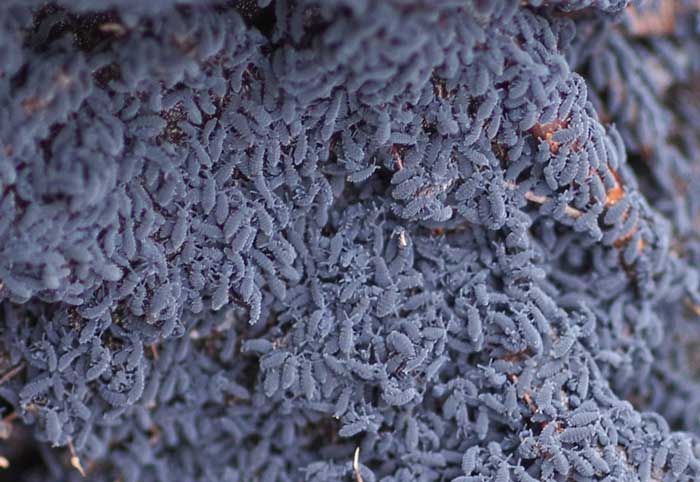 But, the BugLady did a little midnight digging, and found the genus Hypogastrura in The Aquatic Invertebrates of Texas (“typically found on water’s surface, not truly aquatic”), and in Aquatic Insects of Michigan, which listed one genus member as “semi-aquatic” (found on the water’s surface) and two others as “periaquatic” (associated with the edges of aquatic environments). One of the latter was Hypogastrura nivicola, the snow flea.
But, the BugLady did a little midnight digging, and found the genus Hypogastrura in The Aquatic Invertebrates of Texas (“typically found on water’s surface, not truly aquatic”), and in Aquatic Insects of Michigan, which listed one genus member as “semi-aquatic” (found on the water’s surface) and two others as “periaquatic” (associated with the edges of aquatic environments). One of the latter was Hypogastrura nivicola, the snow flea.
A few more words: “epineuston” and “superaquatic” are terms for organisms that float on top of the water. “Nivicola” means “snow dwelling;” its etymology detouring from Sanskrit, proto-Indo-European and proto-Italian through Greek and Latin before making its way into Old English and Old Irish. And, on the topic of Hypogastrura matura, mentioned in the Michigan book but almost nowhere else (it must have been renamed), a Scandinavian resource referred to them as “urine insects.” The BugLady Googled that one, of course, and found more urology hits than she cared to see.
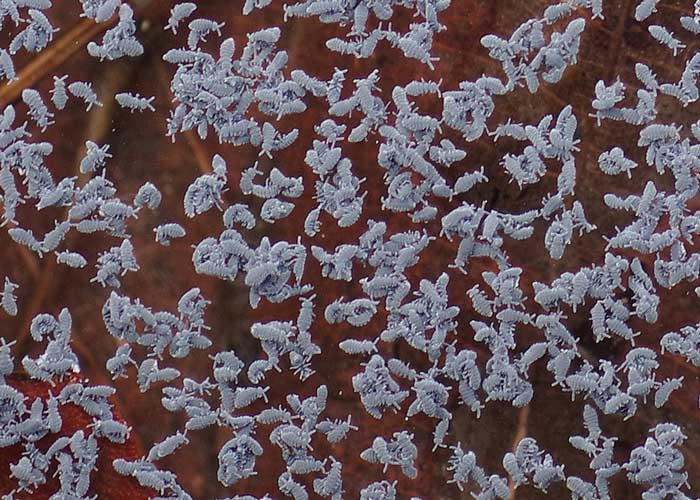 Snow fleas are seriously tiny, 1 mm to 2 mm (about 1/16 of an inch) in length. Visit this link for a photo of snow fleas next to a penny. They engage in mass migrations after snowmelt in spring and again in fall, capable of traveling 30 inches an hour across the damp leaves on the forest floor, and more than 18 feet per day, covering as much as 75 feet before disappearing under the leaves again (according to Walter H. Lyford in a paper published by the University of Notre Dame). Lyford tells us that a colony of snow fleas one foot across can contain one-half to one million individuals, that they grow throughout the fall, and that “mature insects are so heavy that the sound of their bodies landing on dry leaves can be heard distinctly.” Springtail expert Kenneth Christiansen theorizes that these migrations allow them “to find new places to reproduce and to mix the gene pool.”
Snow fleas are seriously tiny, 1 mm to 2 mm (about 1/16 of an inch) in length. Visit this link for a photo of snow fleas next to a penny. They engage in mass migrations after snowmelt in spring and again in fall, capable of traveling 30 inches an hour across the damp leaves on the forest floor, and more than 18 feet per day, covering as much as 75 feet before disappearing under the leaves again (according to Walter H. Lyford in a paper published by the University of Notre Dame). Lyford tells us that a colony of snow fleas one foot across can contain one-half to one million individuals, that they grow throughout the fall, and that “mature insects are so heavy that the sound of their bodies landing on dry leaves can be heard distinctly.” Springtail expert Kenneth Christiansen theorizes that these migrations allow them “to find new places to reproduce and to mix the gene pool.”
Their forays on the snow’s surface are searches for bits of fungi, algae, and bacteria to eat. Most cold-blooded critters get sluggish in winter, but snow fleas have developed a unique antifreeze, a glycine-rich protein that allows them to stay active at temperatures below freezing. Practical applications for this chemical (beyond the very practical snow flea) include extending the life of transplant organs and producing better ice cream.
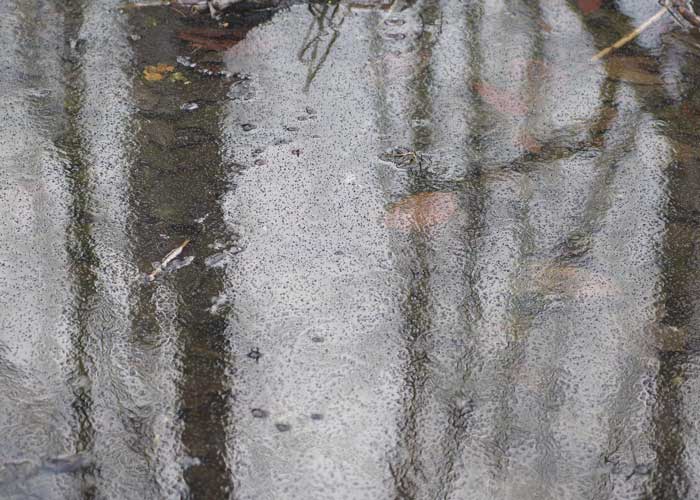 Food for thought: according to Oregon State University researcher Dr. Alan Moldenke, “Every time you take a step in a mature Oregon forest, your foot is being supported on the backs of 16,000 invertebrates held up by an average of 120,000 legs.”
Food for thought: according to Oregon State University researcher Dr. Alan Moldenke, “Every time you take a step in a mature Oregon forest, your foot is being supported on the backs of 16,000 invertebrates held up by an average of 120,000 legs.”
Springtails rule.
The BugLady
